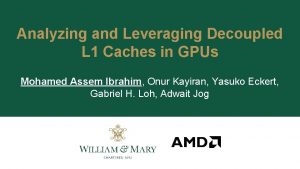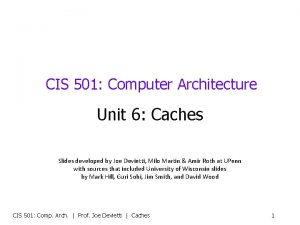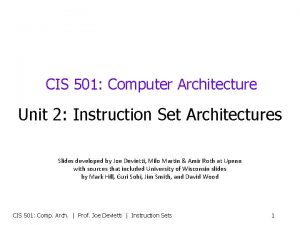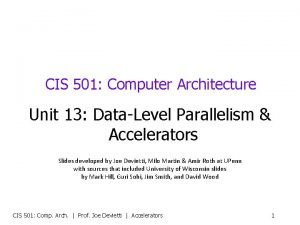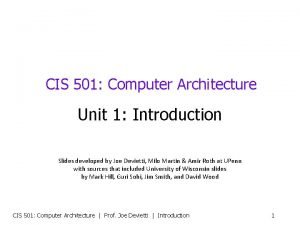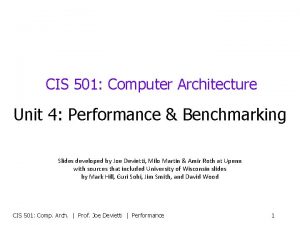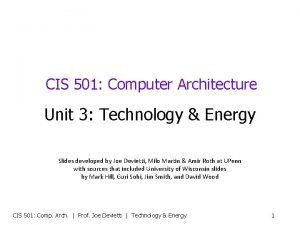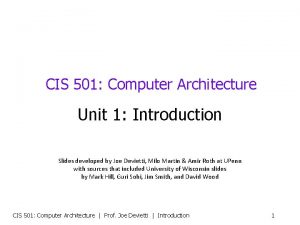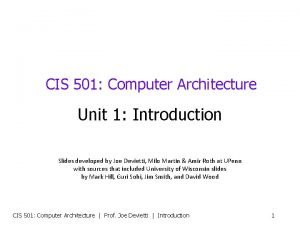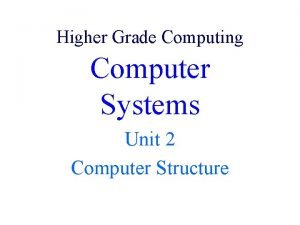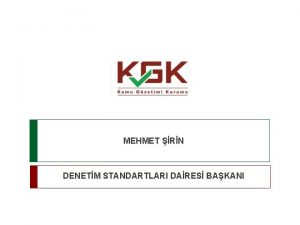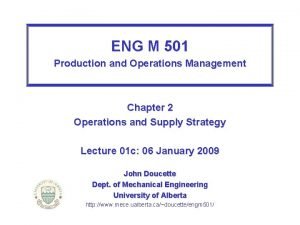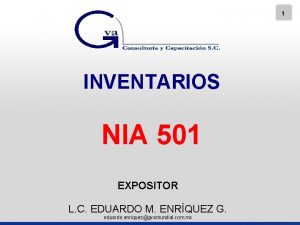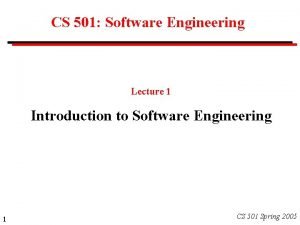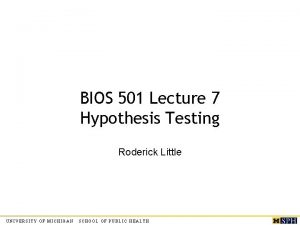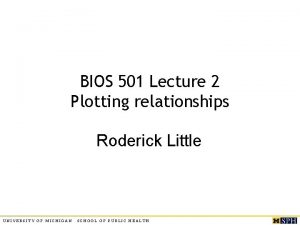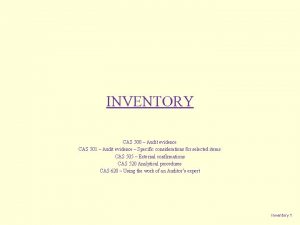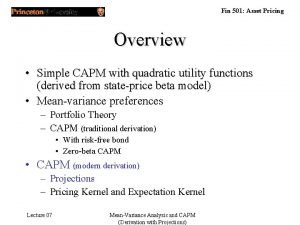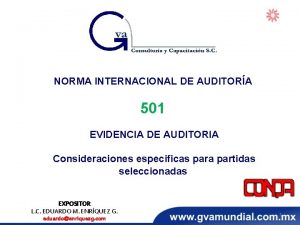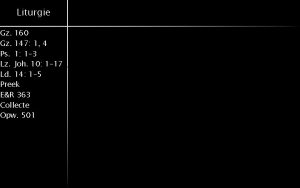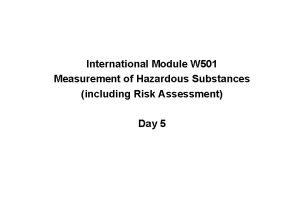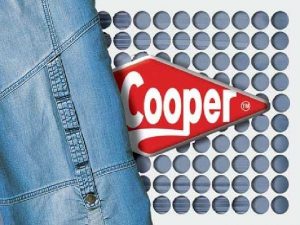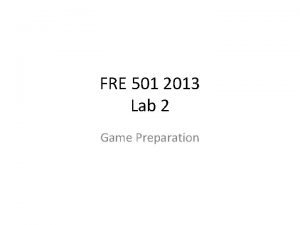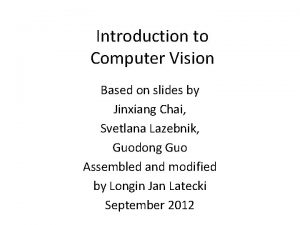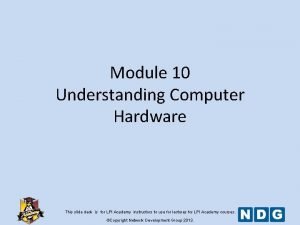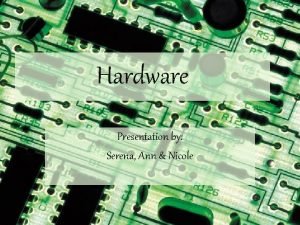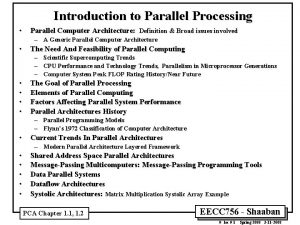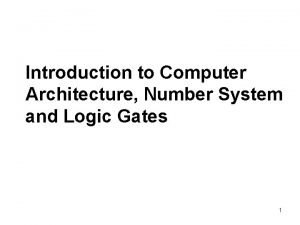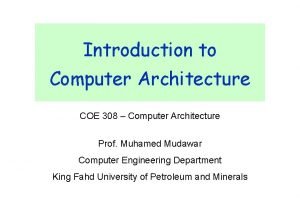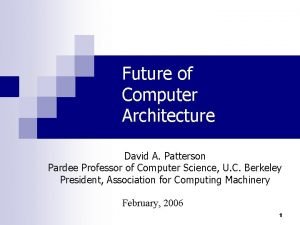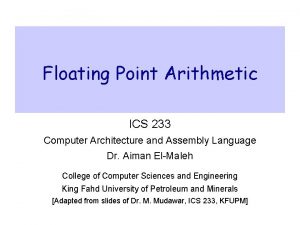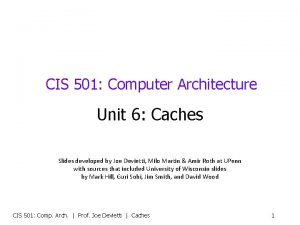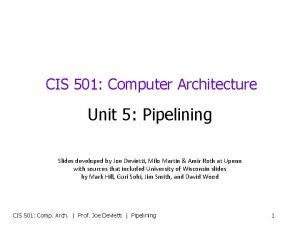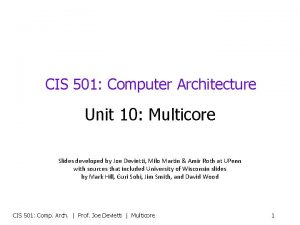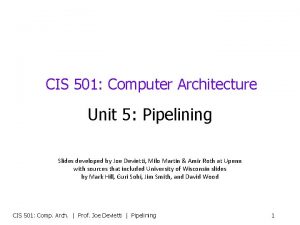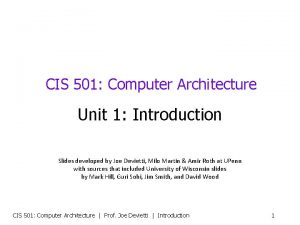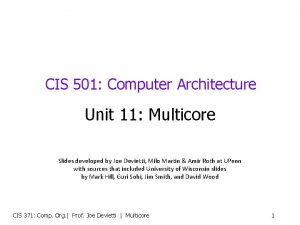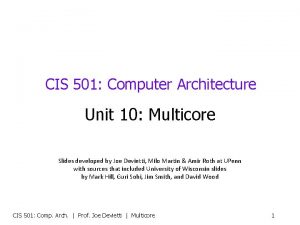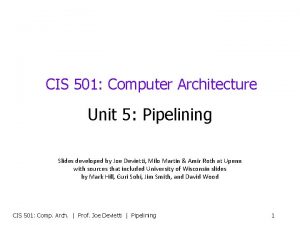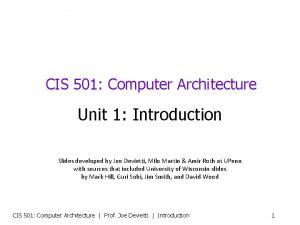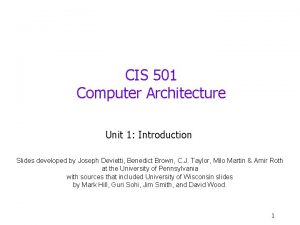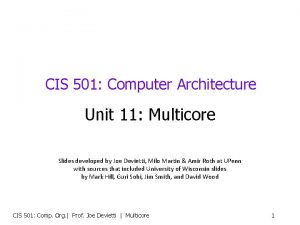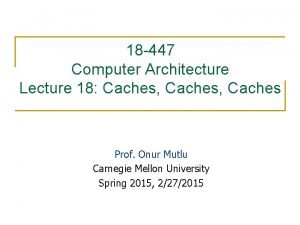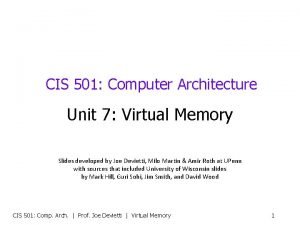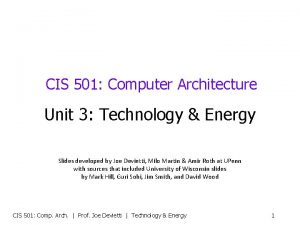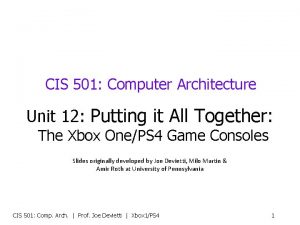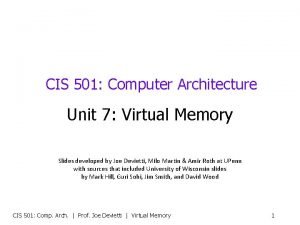CIS 501 Computer Architecture Unit 6 Caches Slides


















































































- Slides: 82

CIS 501: Computer Architecture Unit 6: Caches Slides developed by Joe Devietti, Milo Martin & Amir Roth at UPenn with sources that included University of Wisconsin slides by Mark Hill, Guri Sohi, Jim Smith, and David Wood CIS 501: Comp. Arch. | Prof. Joe Devietti | Caches 1

This Unit: Caches Core I$ D$ L 2 Main Memory • “Cache”: hardware managed • Hardware automatically retrieves missing data • Built from fast on-chip SRAM • In contrast to off-chip, DRAM “main memory” • Average access time of a memory component • latencyavg = latencyhit + (%miss * latencymiss) • Hard to get low latencyhit and %miss in one structure memory hierarchy • Cache ABCs (associativity, block size, capacity) • Performance optimizations • Prefetching & data restructuring • Handling writes • Write-back vs. write-through • Memory hierarchy Disk • Smaller, faster, expensive bigger, slower, cheaper CIS 501: Comp. Arch. | Prof. Joe Devietti | Caches 2

Readings • Paper Review #4: • Jouppi, “Improving Direct-Mapped Cache Performance by the Addition of a Small Fully-Associative Cache and Prefetch Buffers”, ISCA 1990 • ISCA’s “most influential paper award” awarded 15 years later CIS 501: Comp. Arch. | Prof. Joe Devietti | Caches 3

Motivation • Processor can compute only as fast as memory • A 3 Ghz processor can execute an “add” operation in 0. 33 ns • Today’s “main memory” latency is more than 33 ns • Naïve implementation: • loads/stores can be 100 x slower than other operations • Unobtainable goal: • Memory that operates at processor speeds • Memory as large as needed for all running programs • Memory that is cost effective • Can’t achieve all of these goals at once • Example: latency of an SRAM is at least: sqrt(number of bits) CIS 501: Comp. Arch. | Prof. Joe Devietti | Caches 4

MEMORIES (SRAM & DRAM) CIS 501: Comp. Arch. | Prof. Joe Devietti | Caches 5

Types of Memory • Static RAM (SRAM) • 6 or 8 transistors per bit • Two inverters (4 transistors) + transistors for reading/writing • Optimized for speed (first) and density (second) • Fast (sub-nanosecond latencies for small SRAM) • Speed roughly proportional to its area (~ sqrt(number of bits)) • Mixes well with standard processor logic • Dynamic RAM (DRAM) • • 1 transistor + 1 capacitor per bit Optimized for density (in terms of cost per bit) Slow (>30 ns internal access, ~50 ns pin-to-pin) Different fabrication steps (does not mix well with logic) • Nonvolatile storage: Magnetic disk, Flash RAM CIS 501: Comp. Arch. | Prof. Joe Devietti | Caches 6

Memory & Storage Technologies • Cost - what can $200 buy (2009)? • • SRAM: 16 MB DRAM: 4, 000 MB (4 GB) – 250 x cheaper than SRAM Flash: 64, 000 MB (64 GB) – 16 x cheaper than DRAM Disk: 2, 000 MB (2 TB) – 32 x vs. Flash (512 x vs. DRAM) • Latency • • SRAM: <1 to 2 ns (on chip) DRAM: ~50 ns – 100 x or more slower than SRAM Flash: 75, 000 ns (75 microseconds) – 1500 x vs. DRAM Disk: 10, 000 ns (10 ms) – 133 x vs Flash (200, 000 x vs DRAM) • Bandwidth • • SRAM: 300 GB/sec (e. g. , 12 -port 8 -byte register file @ 3 Ghz) DRAM: ~25 GB/s Flash: 0. 25 GB/s (250 MB/s), 100 x less than DRAM Disk: 0. 1 GB/s (100 MB/s), 250 x vs DRAM, sequential access only CIS 501: Comp. Arch. | Prof. Joe Devietti | Caches 7

Memory Technology Trends Cost Copyright Elsevier Scientific 2003 Access Time CIS 501: Comp. Arch. | Prof. Joe Devietti | Caches 8

The “Memory Wall” +35 to 55% Log scale +7% Copyright Elsevier Scientific 2003 • Processors get faster more quickly than memory (note log scale) • Processor speed improvement: 35% to 55% • Memory latency improvement: 7% CIS 501: Comp. Arch. | Prof. Joe Devietti | Caches 9

THE MEMORY HIERARCHY CIS 501: Comp. Arch. | Prof. Joe Devietti | Caches 10

Known From the Beginning “Ideally, one would desire an infinitely large memory capacity such that any particular word would be immediately available … We are forced to recognize the possibility of constructing a hierarchy of memories, each of which has a greater capacity than the preceding but which is less quickly accessible. ” Burks, Goldstine, Von. Neumann “Preliminary discussion of the logical design of an electronic computing instrument” IAS memo 1946 CIS 501: Comp. Arch. | Prof. Joe Devietti | Caches 11

Big Observation: Locality & Caching • Locality of memory references • Empirical property of real-world programs, few exceptions • Temporal locality • Recently referenced data is likely to be referenced again soon • Reactive: “cache” recently used data in small, fast memory • Spatial locality • More likely to reference data near recently referenced data • Proactive: “cache” large chunks of data to include nearby data • Both properties hold for both data and instructions • Cache: “Hash table” of recently used blocks of data • In hardware, finite-sized, transparent to software CIS 501: Comp. Arch. | Prof. Joe Devietti | Caches 12

Spatial and Temporal Locality Example • Which memory accesses demonstrate spatial locality? • Which memory accesses demonstrate temporal locality? int sum = 0; int x[1000]; for(int c = 0; c < 1000; c++) { sum += c; x[c] = 0; } CIS 501: Comp. Arch. | Prof. Joe Devietti | Caches 13

Library Analogy • Consider books in a library • Library has lots of books, but it is slow to access • Far away (time to walk to the library) • Big (time to walk within the library) • How can you avoid these latencies? • Check out books, take them home with you • Put them on desk, on bookshelf, etc. • But desks & bookshelves have limited capacity • Keep recently used books around (temporal locality) • Grab books on related topic at the same time (spatial locality) • Guess what books you’ll need in the future (prefetching) CIS 501: Comp. Arch. | Prof. Joe Devietti | Caches 14

Library Analogy Explained • Registers books on your desk • Actively being used, small capacity • Caches bookshelves • Moderate capacity, pretty fast to access • Main memory library • Big, holds almost all data, but slow • Disk (virtual memory) inter-library loan • Very slow, but hopefully really uncommon CIS 501: Comp. Arch. | Prof. Joe Devietti | Caches 15

Exploiting Locality: Memory Hierarchy CPU M 1 M 2 • Hierarchy of memory components • Upper components • Fast Small Expensive • Lower components • Slow Big Cheap • Connected by “buses” • Which also have latency and bandwidth issues • Most frequently accessed data in M 1 M 3 • M 1 + next most frequently accessed in M 2, etc. • Move data up-down hierarchy • Optimize average access time M 4 • latencyavg=latencyhit + (%miss*latencymiss) • Attack each component CIS 501: Comp. Arch. | Prof. Joe Devietti | Caches 16

Concrete Memory Hierarchy Processor Regs I$ D$ • 0 th level: Registers • 1 st level: Primary caches Compiler Managed • Split instruction (I$) and data (D$) • Typically 8 KB to 64 KB each • 2 nd level: 2 nd and 3 rd cache (L 2, L 3) L 2, L 3 Hardware • On-chip, typically made of SRAM nd Managed • 2 level typically ~256 KB to 512 KB • “Last level cache” typically 4 MB to 16 MB Main Memory Disk • 3 rd level: main memory Software Managed (by OS) • • Made of DRAM (“Dynamic” RAM) • Typically 1 GB to 8 GB for desktops/laptops • Servers can have >1 TB 4 th level: disk (swap and files) • Uses magnetic disks or flash drives CIS 501: Comp. Arch. | Prof. Joe Devietti | Caches 17

Evolution of Cache Hierarchies 64 KB I$ 64 KB D$ 8 KB I/D$ 1. 5 MB L 2 256 KB L 2 (private) Intel 486 8 MB L 3 (shared) Intel Core. L 3 i 7 tags (quad core) • Chips today are 30– 70% cache by area CIS 501: Comp. Arch. | Prof. Joe Devietti | Caches 18

CACHES CIS 501: Comp. Arch. | Prof. Joe Devietti | Caches 19

Analogy to a Software Hashtable • What is a “hash table”? • What is it used for? • How does it work? • Short answer: • Maps a “key” to a “value” • Constant time lookup/insert • Have a table of some size, say N, of “buckets” • Take a “key” value, apply a hash function to it • Insert and lookup a “key” at “hash(key) modulo N” • Need to store the “key” and “value” in each bucket • Need to check to make sure the “key” matches • Need to handle conflicts/overflows somehow (chaining, re-hashing) CIS 501: Comp. Arch. | Prof. Joe Devietti | Caches 20

Hardware Cache Organization • Cache is a hardware hashtable • with one exception: data not always present 32 • The setup • 32 -bit ISA 4 B addresses, 232 B address space • 4 KB, organized as 1 K blocks of 4 B each • Each block can hold a 4 B word • Physical cache implementation • • 1024 • Logical cache organization 10 1 K (1024 bit) by 4 B SRAM Called data array 10 -bit address input 32 -bit data input/output 32 addr CIS 501: Comp. Arch. | Prof. Joe Devietti | Caches data 21

Looking Up A Block • Q: which 10 of the 32 address bits to use? • A: bits [11: 2] • 2 least significant (LS) bits [1: 0] are the offset bits • Locate byte within word • Don’t need these to locate word • Next 10 LS bits [11: 2] are the index bits [11: 2] • These locate the word • Nothing says index must be these bits • But these work best in practice • Why? (think about it) 11: 2 CIS 501: Comp. Arch. | Prof. Joe Devietti | Caches addr data 22

Knowing that You Found It • 220 blocks map to each cache row (set) • How to know which if any is currently there? • Tag each cache word with remaining address bits [31: 12] • Build separate and parallel tag array • 1 K by 21 -bit SRAM • 20 -bit (next slide) tag + 1 valid bit • Lookup algorithm • Read tag indicated by index bits • If tag matches & valid bit set: then: Hit data is good else: Miss data is garbage, wait… 31: 12 11: 2 CIS 501: Comp. Arch. | Prof. Joe Devietti | Caches [11: 2] [31: 12] addr == hit data 23

A Concrete Example • Lookup address x 000 C 14 B 8 • Index = addr [11: 2] = (addr >> 2) & x 3 FF = x 12 E • Tag = addr [31: 12] = (addr >> 12) = x 000 C 1 0000 0000 1100 0001 [31: 12] == 0000 1100 0001 0100 1011 10 00 31: 12 11: 2 CIS 501: Comp. Arch. | Prof. Joe Devietti | Caches addr hit data 24

Calculating Tag Overhead • “ 32 KB cache” means cache holds 32 KB of data • Called capacity • Tag storage is considered overhead • Tag overhead of 32 KB cache with 1024 32 B frames • • • frame is physical structure holding a block, frame size==block size 32 B frame 5 -bit offset 1024 frames 10 -bit index 32 -bit address – 5 -bit offset – 10 -bit index = 17 -bit tag (17 -bit tag + 1 -bit valid) * 1024 frames = 18 Kb tags = 2. 2 KB tags ~6% overhead • What about 64 -bit addresses? • Tag increases to 49 bits, ~20% overhead (worst case) CIS 501: Comp. Arch. | Prof. Joe Devietti | Caches 25

Handling a Cache Miss • What if requested data isn’t in the cache? • How does it get in there? • Cache controller: finite state machine • • Remembers miss address Accesses next level of memory Waits for response Writes data/tag into proper locations • All of this happens on the fill path • Sometimes called backside CIS 501: Comp. Arch. | Prof. Joe Devietti | Caches 26

Cache Examples • 4 -bit addresses 16 B memory • Simpler cache diagrams than 32 -bits • 8 B cache, 2 B blocks • Figure out number of rows/sets • 4 (capacity / block-size) • Figure out how address splits into offset/index/tag bits • Offset: least-significant log 2(block-size) = log 2(2) = 1 0000 • Index: next log 2(number-of-sets) = log 2(4) = 2 0000 • Tag: rest = 4 – 1 – 2 = 1 0000 tag (1 bit) CIS 501: Comp. Arch. | Prof. Joe Devietti | Caches index (2 bits) 1 bit 27

4 -bit Address, 8 B Cache, 2 B Blocks 0000 A 0001 B 0010 C 0011 D 0100 E 0101 F 0110 Main memory tag (1 bit) index (2 bits) 1 bit Load: 1110 Data Set Tag 0 1 G 00 0 A B 0111 H 01 0 C D 1000 I 10 0 E F 1001 J 11 0 G H 1010 K 1011 L 1100 M 1101 N 1110 P 1111 Q CIS 501: Comp. Arch. | Prof. Joe Devietti | Caches 28

4 -bit Address, 8 B Cache, 2 B Blocks 0000 A 0001 B 0010 C 0011 D 0100 E 0101 F 0110 Main memory Load: 1110 tag (1 bit) index (2 bits) 1 bit Miss Data Set Tag 0 1 G 00 0 A B 0111 H 01 0 C D 1000 I 10 0 E F 1001 J 11 0 G H 1010 K 1011 L 1100 M 1101 N 1110 P 1111 Q CIS 501: Comp. Arch. | Prof. Joe Devietti | Caches 29

4 -bit Address, 8 B Cache, 2 B Blocks 0000 A 0001 B 0010 C 0011 D 0100 E 0101 F 0110 Main memory Load: 1110 tag (1 bit) index (2 bits) 1 bit Miss Data Set Tag 0 1 G 00 0 A B 0111 H 01 0 C D 1000 I 10 0 E F 1001 J 11 1 P Q 1010 K 1011 L 1100 M 1101 N 1110 P 1111 Q CIS 501: Comp. Arch. | Prof. Joe Devietti | Caches 30

Cache Misses and Pipeline Stalls + 4 Regfile I$ a D$ d nop • I$ and D$ misses stall pipeline just like data hazards • Stall logic driven by miss signal • Cache “logically” re-evaluates hit/miss every cycle • Block is filled miss signal de-asserts pipeline restarts CIS 501: Comp. Arch. | Prof. Joe Devietti | Caches 31

Cache Performance Equation • For a cache thit Cache %miss tmiss • Access: read or write to cache • Hit: desired data found in cache • Miss: desired data not found in cache • Must get from another component • No notion of “miss” in register file • Fill: action of placing data into cache • %miss (miss-rate): #misses / #accesses • thit: time to read data from (write data to) cache • tmiss: time to read data into cache • Performance metric: average access time tavg = thit + (%miss * tmiss) CIS 501: Comp. Arch. | Prof. Joe Devietti | Caches 32

CPI Calculation with Cache Misses • Parameters • • Simple pipeline with base CPI of 1 Instruction mix: 30% loads/stores I$: %miss = 2%, tmiss = 10 cycles D$: %miss = 10%, tmiss = 10 cycles • What is new CPI? • CPII$ = %miss. I$*tmiss = 0. 02*10 cycles = 0. 2 cycle • CPID$ = %load/store*%miss. D$*tmiss. D$ = 0. 3 * 0. 1*10 cycles = 0. 3 cycle • CPInew = CPI + CPII$ + CPID$ = 1+0. 2+0. 3 = 1. 5 CIS 501: Comp. Arch. | Prof. Joe Devietti | Caches 33

Measuring Cache Performance • Ultimate metric is tavg • Cache capacity and circuits roughly determines thit • Lower-level memory structures determine tmiss • Measure %miss • Hardware performance counters • Simulation CIS 501: Comp. Arch. | Prof. Joe Devietti | Caches 34

Capacity and Performance • Simplest way to reduce %miss: increase capacity + Miss rate decreases monotonically • “Working set”: insns/data program is actively using • Diminishing returns – However thit increases • Latency grows with cache size • what happens to tavg ? %miss “working set” size Cache Capacity • For fixed capacity, reduce %miss by changing organization CIS 501: Comp. Arch. | Prof. Joe Devietti | Caches 35

Block Size • Given capacity, manipulate %miss by changing organization • One option: increase block size 512*512 bit SRAM • Exploit spatial locality • Notice index/offset bits change • Tag remains the same 0 1 2 • Ramifications + + – – Reduce %miss (up to a point) Reduce tag overhead (why? ) Potentially useless data transfer Premature replacement of useful data 510 511 9 -bit = block size [31: 15] CIS 501: Comp. Arch. | Prof. Joe Devietti | Caches [14: 6] [5: 0] address << data hit? 36

Larger Blocks to Lower Tag Overhead • Tag overhead of 32 KB cache with 1024 32 B frames • • • 32 B frames 5 -bit offset 1024 frames 10 -bit index 32 -bit address – 5 -bit offset – 10 -bit index = 17 -bit tag (17 -bit tag + 1 -bit valid) * 1024 frames = 18 Kb tags = 2. 2 KB tags ~6% overhead • Tag overhead of 32 KB cache with 512 64 B frames • • + 64 B frames 6 -bit offset 512 frames 9 -bit index 32 -bit address – 6 -bit offset – 9 -bit index = 17 -bit tag (17 -bit tag + 1 -bit valid) * 512 frames = 9 Kb tags = 1. 1 KB tags ~3% overhead CIS 501: Comp. Arch. | Prof. Joe Devietti | Caches 37

4 -bit Address, 8 B Cache, 4 B Blocks Main memory 0000 A 0001 B 0010 C 0011 D 0100 E 0101 F 0110 G 0 0111 H 1 1000 I 1001 J 1010 K 1011 L 1100 M 1101 N 1110 P 1111 Q Load: 1110 tag (1 bit) index (1 bits) 2 bit Miss Data Set Tag 00 01 10 11 0 A B C D 0 E F G H CIS 501: Comp. Arch. | Prof. Joe Devietti | Caches 38

4 -bit Address, 8 B Cache, 4 B Blocks Main memory 0000 A 0001 B 0010 C 0011 D 0100 E 0101 F 0110 G 0 0111 H 1 1000 I 1001 J 1010 K 1011 L 1100 M 1101 N 1110 P 1111 Q Load: 1110 tag (1 bit) index (1 bits) 2 bit Miss Data Set Tag 00 01 10 11 0 A B C D 1 M N P Q CIS 501: Comp. Arch. | Prof. Joe Devietti | Caches 39

Effect of Block Size on Miss Rate • Two effects on miss rate + Spatial prefetching (good) • For adjacent locations • Turns miss/miss into miss/hit pairs %miss – Interference (bad) • For non-adjacent locations that map to adjacent frames • Turns hits into misses by disallowing simultaneous residence • Consider entire cache as one big block Block Size • Both effects always present • Spatial “prefetching” dominates initially • Depends on size of the cache • Reasonable block sizes are 32 B– 128 B • But also increases traffic • More data moved, not all used CIS 501: Comp. Arch. | Prof. Joe Devietti | Caches 40

Cache Conflicts • Consider two frequently-accessed variables… • What if their addresses have the same “index” bits? • Such addresses “conflict” in the cache • Can’t hold both in the cache at once… • Can result in lots of misses (bad!) • Conflicts increase cache miss rate • Worse, result in non-robust performance • Small program change -> changes memory layout -> changes cache mapping of variables -> dramatically increase/decrease conflicts • How can we mitigate conflicts? 31: 12 11: 2 CIS 501: Comp. Arch. | Prof. Joe Devietti | Caches [11: 2] [31: 12] addr == hit data 41

Associativity • Set-associativity • • • Block can reside in one of few frames Frame groups called sets Each frame in a set called a way This is 2 -way set-associative (SA) 1 -way direct-mapped (DM) 1 -set fully-associative (FA) + Reduces conflicts – Increases latencyhit: • additional tag match & muxing 4 B 4 B [10: 2] [31: 11] == == more associativity 31: 11 10: 2 CIS 501: Comp. Arch. | Prof. Joe Devietti | Caches addr hit data 42

Associativity • Lookup algorithm • Use index bits to find set • Read data/tags in all frames in parallel • Any (match and valid bit), Hit • Notice tag/index/offset bits • Only 9 -bit index (versus 10 -bit for direct mapped) 4 B 4 B [10: 2] [31: 11] == == more associativity 31: 11 10: 2 CIS 501: Comp. Arch. | Prof. Joe Devietti | Caches addr hit data 43

Associativity and Performance • Higher associative caches + Have better (lower) %miss • Diminishing returns – However thit increases • The more associative, the slower • What about tavg? %miss ~5 Associativity • Block-size and number of sets should be powers of two • Makes indexing easier (just rip bits out of the address) • 3 -way set-associativity? No problem CIS 501: Comp. Arch. | Prof. Joe Devietti | Caches 44

Miss Handling & Replacement Policies • Set-associative caches present a new design choice data from memory • On cache miss, which block in set to replace (kick out)? • Add LRU field to each set • “Least recently used” 512 1 513 511 1023 WE • Each access updates LRU bits 0 = = • Pseudo-LRU used for larger associativity caches [31: 15] CIS 501: Comp. Arch. | Prof. Joe Devietti | Caches [14: 5] [4: 0] address << data 45 hit?

Replacement Policies • Set-associative caches present a new design choice • On cache miss, which block in set to replace (kick out)? • Some options • Random • FIFO (first-in first-out) • LRU (least recently used) • Fits with temporal locality, LRU = least likely to be used in future • NMRU (not most recently used) • An easier to implement approximation of LRU • Same as LRU for 2 -way set-associative caches • Belady’s: replace block that will be used furthest in future • Unachievable optimum CIS 501: Comp. Arch. | Prof. Joe Devietti | Caches 46

4 -bit Address, 8 B Cache, 2 B Blocks, 2 -way Main memory 0000 A 0001 B 0010 C 0011 D 0100 E 0101 F 0110 G Set Tag 0 1 0111 H 0 00 A B 1000 I 1 00 C D 1001 J 1010 K 1011 L 1100 M 1101 N 1110 P 1111 Q tag (2 bit) Way 0 index (1 bits) LRU Way 1 Data CIS 501: Comp. Arch. | Prof. Joe Devietti | Caches 1 bit Data Tag 0 1 0 01 E F 1 01 G H 47

4 -bit Address, 8 B Cache, 2 B Blocks, 2 -way Main memory 0000 A 0001 B 0010 C 0011 D 0100 E 0101 F 0110 G Set Tag 0 1 0111 H 0 00 A B 1000 I 1 00 C D 1001 J 1010 K 1011 L 1100 M 1101 N 1110 P 1111 Q tag (2 bit) Load: 1110 index (1 bits) 1 bit Miss Way 0 LRU Way 1 Data CIS 501: Comp. Arch. | Prof. Joe Devietti | Caches Data Tag 0 1 0 01 E F 1 01 G H 48

4 -bit Address, 8 B Cache, 2 B Blocks, 2 -way Main memory 0000 A 0001 B 0010 C 0011 D 0100 E 0101 F 0110 G Set Tag 0 1 0111 H 0 00 A B 1000 I 1 00 C D 1001 J 1010 K 1011 L 1100 M 1101 N 1110 P 1111 Q tag (2 bit) Load: 1110 index (1 bits) 1 bit Miss Way 0 LRU Way 1 Data CIS 501: Comp. Arch. | Prof. Joe Devietti | Caches Data Tag 0 1 0 01 E F 0 11 P Q LRU updated on each access (not just misses) 49

IMPLEMENTING SETASSOCIATIVE CACHES CIS 501: Comp. Arch. | Prof. Joe Devietti | Caches 50

Option#1: Parallel Tag Access • Data and tags actually physically separate • Split into two different memory structures • Option#1: read both structures in parallel: tag 2 -bit index offset 2 -bit = = Four blocks transferred 2 -bit << CIS 501: Comp. Arch. | Prof. Joe Devietti | Caches data 51

Option#2: Serial Tag Access • Tag match first, then access only one data block • Advantages: lower power, fewer wires • Disadvantages: slower tag 2 -bit index offset 2 -bit Serial 4 -bit Core Tags Data Parallel Core Tags = = 2 -bit Data Only one block transferred CIS 501: Comp. Arch. | Prof. Joe Devietti | Caches data << 52

Best of Both? Way Prediction • Predict “way” of block • • Just a “hint” Use the index plus some tag bits Table of n-bit entries for 2 n associative cache Update on mis-prediction or replacement tag 2 -bit index offset 2 -bit • Advantages • Fast • Low-power 4 -bit • Disadvantage Way Predictor • More “misses” = = = CIS 501: Comp. Arch. | Prof. Joe Devietti | Caches 2 -bit hit data << 53

Highly Associative Caches with “CAMs” • CAM: content addressable memory • • Array of words with built-in comparators No separate “decoder” logic Input is value to match (tag) Generates 1 -hot encoding of matching slot • Fully associative cache • Tags as CAM, data as RAM • Effective but somewhat expensive • But cheaper than any other method • Used for high (16 -/32 -way) associativity – No good way to build 1024 -way associativity + No real need for it, either • CAMs are used elsewhere, too… CIS 501: Comp. Arch. | Prof. Joe Devietti | Caches == == == addr hit data 55

CACHE OPTIMIZATIONS CIS 501: Comp. Arch. | Prof. Joe Devietti | Caches 56

Classifying Misses: 3 C Model • Divide cache misses into three categories • Compulsory (cold): never seen this address before • Would miss even in infinite cache • Capacity: miss because cache is too small • Would miss even in fully associative cache • Identify? Consecutive accesses to block separated by access to at least N other distinct blocks (N is number of frames in cache) • Conflict: miss because cache associativity is too low • Identify? All other misses • (Coherence): miss due to external invalidations • Only in shared memory multiprocessors (later) • Calculated by multiple simulations • Simulate infinite cache, fully-associative cache, normal cache • Subtract to find each count CIS 501: Comp. Arch. | Prof. Joe Devietti | Caches 57

Miss Rate: ABC • Why do we care about 3 C miss model? • So that we know what to do to eliminate misses • e. g. if have no conflict misses, increasing associativity won’t help • Associativity + Decreases conflict misses – Increases latencyhit • Block size – Increases conflict/capacity misses + Decreases compulsory misses • No significant effect on latencyhit • Capacity + Decreases capacity misses – Increases latencyhit CIS 501: Comp. Arch. | Prof. Joe Devietti | Caches 58

Reducing Conflict Misses: Victim Buffer • Conflict misses: not enough associativity • High-associativity is expensive, but also rarely needed • 3 blocks mapping to same 2 -way set • Victim buffer (VB): small fully-associative cache • • • Sits on I$/D$ miss path Small so very fast (e. g. , 8 entries) Blocks evicted from I$/D$ are placed in VB On miss, check VB: hit? Place block back in I$/D$ 8 extra ways, shared among all sets + Only a few sets will need it at any given time + Very effective in practice CIS 501: Comp. Arch. | Prof. Joe Devietti | Caches I$/D$ VB L 2 59

Overlapping Misses: Lockup Free Cache • Lockup free: allows other accesses while miss is pending • Consider: Load [r 1] -> r 2; Load [r 3] -> r 4; Add r 2, r 4 -> r 5 • Handle misses in parallel • Allows “overlapping” misses • “memory-level parallelism” • Implementation: miss status holding register (MSHR) • Remember: miss address, chosen frame, requesting instruction • When miss returns know where to put block, who to inform CIS 501: Comp. Arch. | Prof. Joe Devietti | Caches 60

Prefetching • Bring data into cache proactively/speculatively • If successful, reduces number of cache misses • Key: anticipate upcoming miss addresses accurately • Can do in software or hardware • Simple hardware prefetching: next block prefetching • Miss on address X anticipate miss on X+block-size + Works for insns: sequential execution + Works for data: arrays • Table-driven hardware prefetching I$/D$ • Use predictor to detect strides, common patterns • Effectiveness determined by: prefetch logic • Timeliness: initiate prefetches sufficiently in advance • Coverage: prefetch for as many misses as possible • Accuracy: don’t pollute with unnecessary data CIS 501: Comp. Arch. | Prof. Joe Devietti | Caches L 2 61

Software Prefetching • Use a special “prefetch” instruction • Tells the hardware to bring in data, doesn’t actually read it • Just a hint • Inserted by programmer or compiler • Example int tree_add(tree_t* t) { if (t == NULL) return 0; __builtin_prefetch(t->left); return t->val + tree_add(t->right) + tree_add(t->left); } • Multiple prefetches bring multiple blocks in parallel • More “memory-level” parallelism (MLP) CIS 501: Comp. Arch. | Prof. Joe Devietti | Caches 62

Software Restructuring: Data • Capacity misses: poor spatial or temporal locality • Several code restructuring techniques to improve both • Loop blocking (break into cache-sized chunks), loop fusion – Compiler must know that restructuring preserves semantics • Loop interchange: spatial locality • Example: for a row-major matrix, X[i][j] should be followed by X[i][j+1] • Poor code: X[i][j] followed by X[i+1][j] for (j = 0; j<NCOLS; j++) for (i = 0; i<NROWS; i++) sum += X[i][j]; • Better code for (i = 0; i<NROWS; i++) for (j = 0; j<NCOLS; j++) sum += X[i][j]; CIS 501: Comp. Arch. | Prof. Joe Devietti | Caches 63

Software Restructuring: Data • Loop blocking: temporal locality • Poor code for (k=0; k<NUM_ITERATIONS; k++) for (i=0; i<NUM_ELEMS; i++) X[i] = f(X[i]); // say • Better code • Cut array into CACHE_SIZE chunks • Run all phases on one chunk, proceed to next chunk for (i=0; i<NUM_ELEMS; i+=CACHE_SIZE) for (k=0; k<NUM_ITERATIONS; k++) for (j=0; j<CACHE_SIZE; j++) X[i+j] = f(X[i+j]); – Assumes you know CACHE_SIZE, do you? CIS 501: Comp. Arch. | Prof. Joe Devietti | Caches 64

Software Restructuring: Code • Compiler can layout code for better locality • If (a) { code 1; } else { code 2; } code 3; • But, code 2 case never happens (say, error condition) Better locality • Fewer taken branches, too CIS 501: Comp. Arch. | Prof. Joe Devietti | Caches 65

WHAT ABOUT STORES? CIS 501: Comp. Arch. | Prof. Joe Devietti | Caches 66

Handling Cache Writes • When to propagate new value to (lower level) memory? • Option #1: Write-through: immediately • On hit, update cache • Immediately send the write to the next level • Option #2: Write-back: when block is replaced • Requires additional “dirty” bit per block • Replace clean block: no extra traffic $ • Replace dirty block: extra “writeback” of block 2 WBB + Writeback-buffer (WBB): 1 • Hide latency of writeback (keep off critical path) 4 3 • Step#1: Send “fill” request to next-level • Step#2: While waiting, write dirty block to buffer Next-level-$ • Step#3: When new blocks arrives, put it into cache • Step#4: Write buffer contents to next-level CIS 501: Comp. Arch. | Prof. Joe Devietti | Caches 67

Determining WBB Size • • How big should we make the L 1’s WBB? L = λW (Little’s Law) L = (%miss. L 1) * (latency. L 2) configuration: • • • 1 GHz processor 20% of insns are loads %miss. L 1=5% L 2 access = 20 cycles L =. 01 * 20 1 entry suffices CIS 501: Comp. Arch. | Prof. Joe Devietti | Caches 68

Write Propagation Comparison • Write-through – Creates additional traffic • Consider repeated write hits – Next level must handle small writes (1, 2, 4, 8 -bytes) + No need for dirty bits in cache + No need to handle “writeback” operations • Simplifies miss handling (no write-back buffer) • Sometimes used for L 1 caches (IBM, GPUs) • Usually write-non-allocate: on write miss, just write to next level • Write-back + • • Key advantage: uses less bandwidth Reverse of other pros/cons above Used by Intel, AMD, and many ARM cores Second-level and beyond are generally write-back caches Usually write-allocate: on write miss, fill block from next level CIS 501: Comp. Arch. | Prof. Joe Devietti | Caches 69

Write Misses and Store Buffers • Read miss? • Load can’t go on without the data, it must stall • Write miss? Processor • Technically, no instruction is waiting for data, why stall? • Store buffer: a small buffer • • • + – Stores put address/value to store buffer, keep going Store buffer writes stores to D$ in the background Loads must search store buffer (in addition to D$) Eliminates stalls on write misses (mostly) WBB Creates some problems in multiprocessors (later) • Store buffer vs. writeback-buffer • Store buffer: “in front” of D$, for hiding store misses • Writeback buffer: “behind” D$, for hiding writebacks CIS 501: Comp. Arch. | Prof. Joe Devietti | Caches SB Cache Next-level cache 70

CACHE HIERARCHIES CIS 501: Comp. Arch. | Prof. Joe Devietti | Caches 71

Concrete Memory Hierarchy Processor Regs I$ D$ • 0 th level: Registers • 1 st level: Primary caches Compiler Managed • Split instruction (I$) and data (D$) • Typically 8 KB to 64 KB each • 2 nd level: 2 nd and 3 rd cache (L 2, L 3) L 2, L 3 Hardware • On-chip, typically made of SRAM Managed • 2 nd level typically ~256 KB to 512 KB • “Last level cache” typically 4 MB to 16 MB Main Memory Disk • 3 rd level: main memory Software Managed (by OS) • Made of DRAM (“Dynamic” RAM) • Typically 1 GB to 4 GB for desktops/laptops • Servers can have >1 TB • 4 th level: disk (swap and files) • Uses magnetic disks or flash drives CIS 501: Comp. Arch. | Prof. Joe Devietti | Caches 72

Designing a Cache Hierarchy • For any memory component: thit vs. %miss tradeoff • Upper components (I$, D$) emphasize low thit • • • Frequent access thit important tmiss is low %miss less important Lower capacity and lower associativity (to reduce thit) Small-medium block-size (to reduce conflicts) Split instruction & data cache to allow simultaneous access • Moving down (L 2, L 3) emphasis turns to %miss • • Infrequent access thit less important tmiss is high %miss important High capacity, associativity, and block size (to reduce % miss) Unified insn+data caches to dynamically allocate capacity CIS 501: Comp. Arch. | Prof. Joe Devietti | Caches 73

Split vs. Unified Caches • Split I$/D$: insns and data in different caches • To minimize structural hazards and thit • Larger unified I$/D$ would be slow, 2 nd port even slower • Optimize I$ to fetch multiple instructions, no writes • Unified L 2, L 3: insns and data together • To minimize %miss + Fewer capacity misses: unused insn capacity can be used for data – More conflict misses: insn/data conflicts • A much smaller effect in large caches • Insn/data structural hazards are rare: simultaneous I$/D$ miss • Go even further: unify L 2/L 3 of multiple cores in a multi-core CIS 501: Comp. Arch. | Prof. Joe Devietti | Caches 75

Hierarchy: Inclusion versus Exclusion • Inclusion • Bring block from memory into L 2 then L 1 • A block in the L 1 is always in the L 2 (but not vice-versa) • If block evicted from L 2, must also evict it from L 1 • Why? more on this when we talk about multicore • Exclusion • Bring block from memory into L 1 but not L 2 • Move block to L 2 on L 1 eviction • L 2 becomes a large victim cache • Block is either in L 1 or L 2 (never both) • Good if L 2 is small relative to L 1 • Example: AMD’s Duron 64 KB L 1 s, 64 KB L 2 • Non-inclusion • No guarantees CIS 501: Comp. Arch. | Prof. Joe Devietti | Caches 76

Memory Performance Equation • For memory component M CPU thit M %miss tmiss • Access: read or write to M • Hit: desired data found in M • Miss: desired data not found in M • Must get from another (slower) component • Fill: action of placing data in M • %miss (miss-rate): #misses / #accesses • thit: time to read data from (write data to) M • tmiss: time to read data into M • Performance metric • tavg: average access time tavg = thit + (%miss * tmiss) CIS 501: Comp. Arch. | Prof. Joe Devietti | Caches 77

Hierarchy Performance CPU tavg = tavg-M 1 tmiss-M 1 = tavg-M 2 tmiss-M 2 = tavg-M 3 tavg-M 1 thit-M 1 + … (%miss-M 1*tmiss-M 1) (%miss-M 1*tavg-M 2) (%miss-M 1*(thit-M 2 + (%miss-M 2*tmiss-M 2))) (%miss-M 1* (thit-M 2 + (%miss-M 2*tavg-M 3))) M 3 tmiss-M 3 = tavg-M 4 CIS 501: Comp. Arch. | Prof. Joe Devietti | Caches 78

Performance Calculation • In a pipelined processor, I$/D$ thit is “built in” (effectively 0) • Parameters • • Base pipeline CPI = 1 Instruction mix: 30% loads/stores I$: %miss = 2%, tmiss = 10 cycles D$: %miss = 10%, tmiss = 10 cycles • What is CPI with cache misses? • CPII$ = %miss. I$*tmiss = 0. 02*10 cycles = 0. 2 cycle • CPID$ = %memory*%miss. D$*tmiss. D$ = 0. 30*0. 10*10 cycles = 0. 3 cycle • CPInew = CPI + CPII$ + CPID$ = 1+0. 2+0. 3= 1. 5 CIS 501: Comp. Arch. | Prof. Joe Devietti | Caches 79

Miss Rates: per “access” vs “instruction” • Miss rates can be expressed two ways: • Misses per “instruction” (or instructions per miss), -or • Misses per “cache access” (or accesses per miss) • For first-level caches, use instruction mix to convert • If memory ops are 1/3 rd of instructions. . • 2% of instructions miss (1 in 50) is 6% of “accesses” miss (1 in 17) • What about second-level caches? • Misses per “instruction” still straight-forward (“global” miss rate) • Misses per “access” is trickier (“local” miss rate) • Depends on number of accesses (which depends on L 1 miss rate) CIS 501: Comp. Arch. | Prof. Joe Devietti | Caches 80

Performance Calculation (Revisited) • Parameters • Base pipeline CPI = 1 • In this case, already incorporates thit • I$: %miss = 2% of instructions, tmiss = 10 cycles • D$: %miss = 3% of instructions, tmiss = 10 cycles • What is new CPI? • CPII$ = %miss. I$*tmiss = 0. 02*10 cycles = 0. 2 cycle • CPID$ = %miss. D$*tmiss. D$ = 0. 03*10 cycles = 0. 3 cycle • CPInew = CPI + CPII$ + CPID$ = 1+0. 2+0. 3= 1. 5 CIS 501: Comp. Arch. | Prof. Joe Devietti | Caches 81

Multilevel Performance Calculation • Parameters • • 30% of instructions are memory operations L 1: thit = 1 cycles (included in CPI of 1), %miss = 5% of accesses L 2: thit = 10 cycles, %miss = 20% of L 2 accesses Main memory: thit = 50 cycles • Calculate CPI • CPI = 1 + 30% * 5% * tmiss. D$ • tmiss. D$ = tavg. L 2 = thit. L 2+(%miss. L 2*thit. Mem )= 10 + (20%*50) = 20 cycles • Thus, CPI = 1 + 30% * 5% * 20 = 1. 3 CPI • Alternate CPI calculation: • What % of instructions miss in L 1 cache? 30%*5% = 1. 5% • What % of instructions miss in L 2 cache? 20%*1. 5% = 0. 3% of insn • CPI = 1 + (1. 5% * 10) + (0. 3% * 50) = 1 + 0. 15 = 1. 3 CPI CIS 501: Comp. Arch. | Prof. Joe Devietti | Caches 82

Cache Glossary tag array data array frame block/line valid bit tag set/row way block offset/displacement address: tag CIS 501: Comp. Arch. | Prof. Joe Devietti | Caches index 83

Summary Core I$ D$ L 2 Main Memory • “Cache”: hardware managed • Hardware automatically retrieves missing data • Built from fast on-chip SRAM • In contrast to off-chip, DRAM “main memory” • Average access time of a memory component • latencyavg = latencyhit + (%miss * latencymiss) • Hard to get low latencyhit and %miss in one structure memory hierarchy • Cache ABCs (associativity, block size, capacity) • Performance optimizations • Prefetching & data restructuring • Handling writes • Write-back vs. write-through • Memory hierarchy Disk • Smaller, faster, expensive bigger, slower, cheaper CIS 501: Comp. Arch. | Prof. Joe Devietti | Caches 84
 Analyzing and leveraging decoupled l1 caches in gpus
Analyzing and leveraging decoupled l1 caches in gpus L caches
L caches Cis 501
Cis 501 Cis 501
Cis 501 Cis 501
Cis 501 Cis 501
Cis 501 Cis 501
Cis 501 Cis 501
Cis 501 Cis 501
Cis 501 Joe devietti
Joe devietti A small child slides down the four frictionless slides
A small child slides down the four frictionless slides Force and work relationship quick check
Force and work relationship quick check Buses in computer architecture
Buses in computer architecture Computer architecture vs organization
Computer architecture vs organization What is basic computer organization
What is basic computer organization Arithmetic and logic unit
Arithmetic and logic unit Unit 2 computer systems
Unit 2 computer systems Architecture runway slides
Architecture runway slides Salarisschaal 501
Salarisschaal 501 Rimskych 501
Rimskych 501 Bds 501
Bds 501 Somos um pequeno povo mui feliz
Somos um pequeno povo mui feliz Eng m 501
Eng m 501 Ariane 5 flight 501
Ariane 5 flight 501 Dev 501
Dev 501 Pix
Pix Aseveraciones de inventarios
Aseveraciones de inventarios Tyler sis wgsd
Tyler sis wgsd Hinario 501
Hinario 501 Cs 501
Cs 501 Bios 501
Bios 501 Bios 501
Bios 501 Mgt 501
Mgt 501 Mgt 501
Mgt 501 Cas 501
Cas 501 I 501
I 501 I 501
I 501 Mgt 501
Mgt 501 Acilyse
Acilyse 501
501 501
501 Norma 501
Norma 501 Opwekking 501
Opwekking 501 W 501
W 501 Maurice cooper
Maurice cooper Ubc canvs
Ubc canvs Computer vision slides
Computer vision slides Computer hardware slides
Computer hardware slides Hardware presentation
Hardware presentation Unit 10, unit 10 review tests, unit 10 general test
Unit 10, unit 10 review tests, unit 10 general test Software architecture business cycle
Software architecture business cycle Call and return architecture in software engineering
Call and return architecture in software engineering Architecture
Architecture Modular product architectures
Modular product architectures Computer organization and architecture 10th solution
Computer organization and architecture 10th solution Ocs architecture
Ocs architecture Computer architecture virtual lab
Computer architecture virtual lab Introduction to computer organization and architecture
Introduction to computer organization and architecture Timing and control in computer architecture
Timing and control in computer architecture Computer architecture: concepts and evolution
Computer architecture: concepts and evolution Programmed i/o in computer architecture
Programmed i/o in computer architecture Floating point division algorithm in computer architecture
Floating point division algorithm in computer architecture Absolute addressing mode in computer architecture
Absolute addressing mode in computer architecture Chordal ring
Chordal ring Smt computer architecture
Smt computer architecture Pseudo instructions
Pseudo instructions Collision prevention in computer architecture
Collision prevention in computer architecture Instruction format in computer architecture
Instruction format in computer architecture What is nano programming
What is nano programming Memory system design in computer architecture
Memory system design in computer architecture Memory hierarchy
Memory hierarchy Linear and non linear pipeline
Linear and non linear pipeline Computer architecture definition
Computer architecture definition Define parallelism in computer architecture
Define parallelism in computer architecture Number system in computer architecture
Number system in computer architecture Computer architecture definition
Computer architecture definition Types of instruction sets
Types of instruction sets Input and output devices
Input and output devices Branch prediction
Branch prediction Computer architecture david patterson
Computer architecture david patterson Single instruction single data
Single instruction single data What is guard bit in computer architecture
What is guard bit in computer architecture Bus interconnection in computer architecture
Bus interconnection in computer architecture
